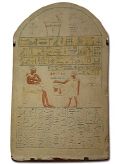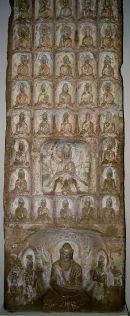Stele


A stele (from Greek: στήλη, stēlē, IPA: [ˈstili]; plural: stelae, στῆλαι, stēlai, IPA: [ˈstilaɪ]; also found: Latinised singular stela and Anglicised plural steles) is a stone or wooden slab, generally taller than it is wide, erected for funerary or commemorative purposes, most usually decorated with the names and titles of the deceased or living—inscribed, carved in relief (bas-relief, sunken-relief, high-relief, etc), or painted onto the slab.
Stelae were also used as territorial markers, as the boundary stelae of Akhenaton at Amarna, or to commemorate military victories. They were widely used in the Ancient Near East, Greece, Egypt, Ethiopia, and, quite independently, in China and some Buddhist cultures (see the Nestorian Stele), and, more surely independently, by Mesoamerican civilisations, notably the Olmec and Maya. The huge number of stelae surviving from ancient Egypt and in Central America constitute one of the largest and most significant sources of information on those civilisations. An informative stele of Tiglath-Pileser III is preserved in the British Museum. Two stelae built into the walls of a church are major documents relating to the Etruscan language.
Unfinished standing stones, set up without inscriptions from Libya in North Africa to Scotland were monuments of pre-literate Megalithic cultures in the Late Stone Age.
In 1489, 1512, and 1663 C.E., the Kaifeng Jews of China left these stone monuments to preserve their origin and history. Despite repeated flooding of the Yellow River, destroying their synagogue time and time again, these stelae survived to tell their tale.
An obelisk is a specialized kind of stele. The High crosses of Ireland, Scotland and Wales i.e. Celtic areas of Britain are specialized stelae. A modern gravestone with its inscribed epitaph is also a kind of stele.
Most recently, in the Memorial to the Murdered Jews of Europe in Berlin, the architect Peter Eisenman created a field of some 2,700 blank stelae. The memorial is meant to be read not only as the field, but also as an erasure of datum that refers to memory of the Holocaust.


Notable individual stelae
- Axumite Stele
- Code of Hammurabi
- Gwanggaeto Stele
- Nestorian Stele
- Ukrainian stone stela
- Lemnos stela
- Lapis Niger
- For Israel/Egypt:
- Merneptah Stele
- Mesha Stele
- For Egypt:
- Boundary Stelae of Akhenaten
- Palermo stone
- Stèle of Revealing – (Egyptian Museum stele, catalogue number 666)
- In the Western Hemisphere:
- Peru: Raimondi Stela
- Mexico: Stela C at Tres Zapotes
- Mexico: Izapa Stela 5
See also
- Inscription
- Stele Forest, in Xi'an, China
- Rune stone
- Monumental inscription

Credits
New World Encyclopedia writers and editors rewrote and completed the Wikipedia article in accordance with New World Encyclopedia standards. This article abides by terms of the Creative Commons CC-by-sa 3.0 License (CC-by-sa), which may be used and disseminated with proper attribution. Credit is due under the terms of this license that can reference both the New World Encyclopedia contributors and the selfless volunteer contributors of the Wikimedia Foundation. To cite this article click here for a list of acceptable citing formats.The history of earlier contributions by wikipedians is accessible to researchers here:
The history of this article since it was imported to New World Encyclopedia:
Note: Some restrictions may apply to use of individual images which are separately licensed.
